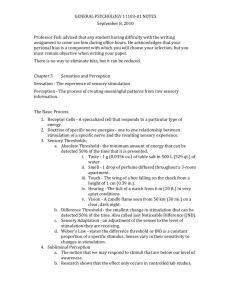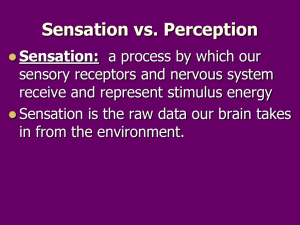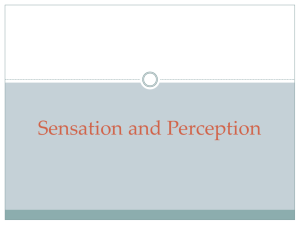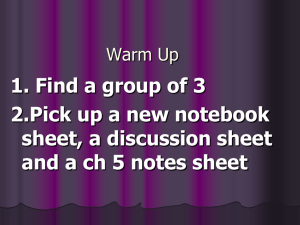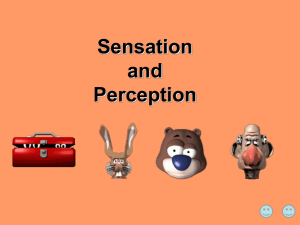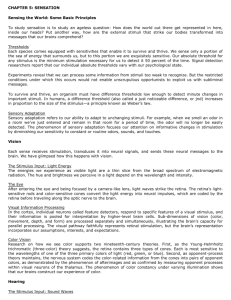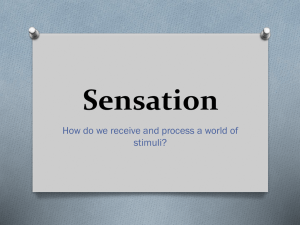Parallel Processing
advertisement
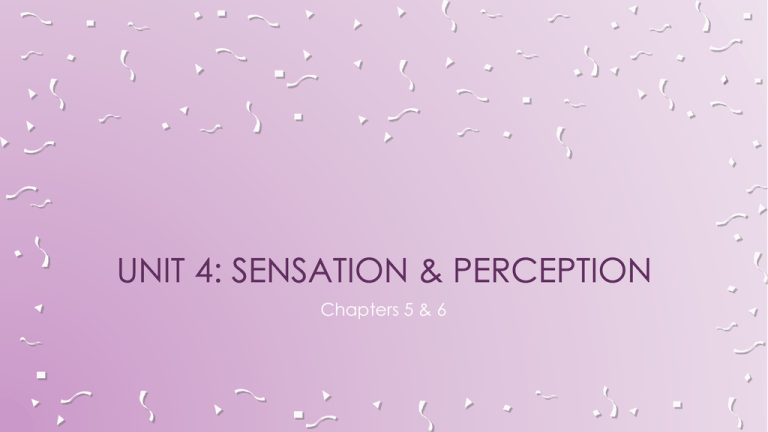
Chapters 5 & 6 Sensation: a process by which our sensory receptors and nervous system receive and represent stimulus energy Sensation is the raw data our brain takes in from the environment. Perception: a process of organizing and interpreting sensory information, enabling us to recognize meaningful objects and events. Perception “makes sense” of sensation. Both involve one continuous process and perceptual failure may occur at any level whether at the sensory level or the perceptual interpretation level. Example: Prosopagnosia https://www.youtube.com/watch?v=vwCrxomPbtY http://www.cbsnews.com/news/face-blindness-when- everyone-is-a-stranger-20-03-2012/ Bottom Up Processing: analysis that begins with the sense receptors and works up to the brain’s integration of sensory information. Involves making sense of raw sensation. Top Down Processing: Information processing guided by higher-level mental processes As when we construct perceptions drawing on our experience and expectations. Our expectations and experiences shape how we perceive information. What am I seeing? Bottom-up processing: taking sensory information and then assembling and integrating it Top-down processing: using models, ideas, and expectations to interpret sensory information Is that something I’ve seen before? Top-down Processing You may start to see something in this picture if we give your brain some concepts to apply: “tree” “sidewalk” “dog” “Dalmatian” What do you see? study of the relationship between physical characteristics of stimuli and our psychological experience of them Light- brightness Sound- volume Pressure- weight Taste- sweetness Absolute Threshold: minimum stimulation needed to detect a particular stimulus. Usually defined as the stimulus needed for detection 50% of the time. Signal Detection Theory: predicts how and when we detect the presence of a faint stimulus (signal) amid background stimulation (noise) Assumes that there is no single absolute threshold What might a person’s detection of a stimulus depend on? Stimuli you cannot detect 50% of the time Below one’s absolute threshold What does the research say? http://jeffmilner.com/backmasking/ https://www.youtube.com/watch?v=L6pgoqZpfUU Difference Threshold or (JND-Just Noticeable Difference): the minimum difference that a person can detect between two stimuli. What does it take to tell two similar stimuli apart? Weber’s Law: to perceive a difference between two stimuli, they must differ by a constant minimum percentage light intensity- 8% weight- 2% tone frequency- 0.3% • The JND is always large when the stimulus intensity is high, and small when the stimulus intensity is low 2 stimuli must differ by a constant proportion – Example: Think volume of tv or radio – • (if the volume is low, then you only need to increase it a little to notice the difference, in contrast, if the volume is high, then you need to decrease it a significant amount to notice it) – http://www.youtube.com/watch?v=zo7FpI8MmmE Sensory Adaptation: diminished sensitivity with constant stimulation. Ocean Bad Smell Ads- cut in, zoom, fade out Transduction- conversion of one form of energy to another. Wavelength- the distance from the peak of one wave to the peak of the next. Hue- dimension of color determined by wavelength of light…color is matter of how far wavelengths are apart. Intensity- amount of energy in a wave determined by amplitude. brightness loudness ROY G. BIV: Starts from longer to shorter wavelengths. R=longest; V=shortest Short wavelength=high frequency (bluish colors, high-pitched sounds) Great amplitude (bright colors, loud sounds) Long wavelength=low frequency (reddish colors, low-pitched sounds) Small amplitude (dull colors, soft sounds) The process of sensation can be seen as three steps: Reception-- the stimulation of sensory receptor cells by energy (sound, light, heat, etc) Transduction-transforming this cell stimulation into neural impulses Transmission-delivering this neural information to the brain to be processed 1.) Light enters the eye through the cornea: (transparent protector) and the light passes through the pupil: (small opening/hole). The size of the opening (pupil) is regulated by the iris: the colored portion of your eye that is a muscular tissue which widens or constricts the pupil causing either more or less light to get in. 2.) Behind the pupil, the lens, a transparent structure, changes its curvature in a process called accommodation, and focuses the light rays into an image on the light-sensitive back surface called the retina: where image is focuses. Light from the candle passes through the cornea and the pupil, and gets focused and inverted by the lens. The light then lands on the retina, where it begins the process of transduction into neural impulses to be sent out through the optic nerve. The lens is not rigid; it can perform accommodation by changing shape to focus on near or far objects. The images we “see” are not made of light; they are made of neural signals which can be produced even by pressure on the eyeball. Once neural signals enter the optic nerve, they are sent through the thalamus to the visual cortex. 3.) Image coming through activates photoreceptors in the retina called rods and cones. As rods and cones set off chemical reactions they form a synapse with bipolar cells which forms a synapse with ganglion cells which fire action potentials along the optic nerve: that carries this information to be processed by the Thalamus: (sensory switchboard) that sends information to the visual cortex which resides in the occipital lobe. The brain then constructs what you are seeing and turns image right side up. When light reaches the back of the retina, it triggers chemical changes in the receptor cells, called rods and cones. The rods and cones in turn send messages to ganglion and bipolar cells and on to the optic nerve. Rods help us see the black and white actions in our peripheral view and in the dark. Rods are about 20 times more common than cones, which help us see sharp colorful details in bright light. Blind Spot: part of retina where optic nerve leaves the eye…no receptor cells are there. Brain fills information in with info from other eye. Fovea: central focal point of the retina, where cones cluster. Cones: located near center of retina (fovea) fine detail and color vision daylight or well-lit conditions Rods: located near peripheral retina detect black, white and gray twilight or low light Acuity: the sharpness of vision Nearsightedness: nearby objects seen more clearly lens focuses image of distant objects in front of retina Farsightedness: faraway objects seen more clearly lens focuses near objects behind retina Parallel vs. Serial: parallel means simultaneous while serial means step by step. Our brains process are often parallel processes while computers work serially. Parallel Processing: simultaneous processing of several dimensions through multiple pathways. Different part of brain for: color motion form depth Turning light into the mental act of seeing: light waveschemical reactionsneural impulsesfeaturesobjects and one more step... Parallel processing refers to building perceptions out of sensory details processed in different areas of the brain. For example: Feature Detectors: neurons in the visual cortex respond to specific features shape angle movement Trichromatic Young (three color) Theory and Helmholtz three different retinal color receptors red green blue We see the color of an orange because it absorbs all light except the wavelengths that our brain interprets as orange. You could note that the red, green and blue don’t actually refer to the appearance of the cones; they are the colors to which these three cones react. People who suffer redgreen blindness have trouble perceiving the number within the design Opponent-Process Theory- opposing retinal processes enable color vision. Example: Jesus On Title Slide. “ON” “OFF” red green green red blue yellow yellow blue black white white black Opponent-Process Theory Test The dot, the dot, keep staring at the dot in the center… Human Beings maintain Color Constancy: perceiving familiar objects as having consistent color, even if lighting changes to alter the wavelength given off by the object. http://www.brainbashers.com/showillusion.asp?129 We only retain color constancy when the context remains the same. Same color will look different when compared in different contexts.

